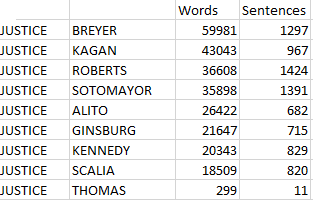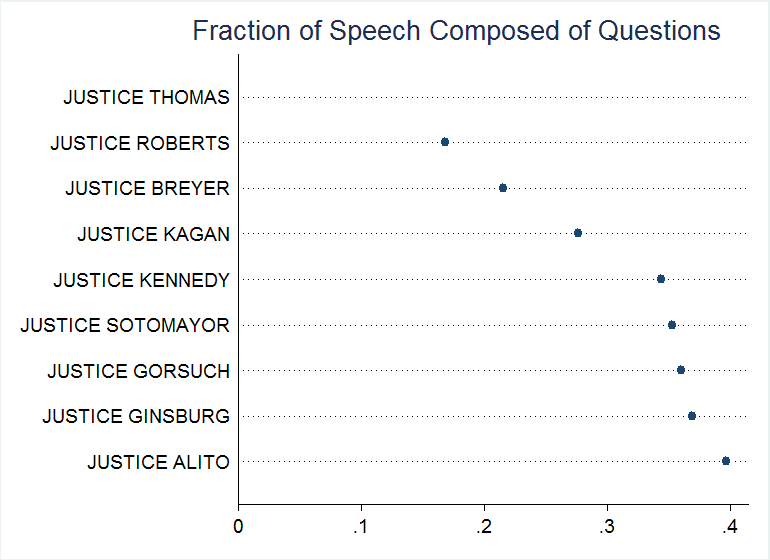Supreme Court oral arguments are the only times that litigators directly and verbally interact with the Justices about pending cases. The scholarship on whether these arguments factor into decision outcomes is mixed with some suggesting that the Justices come into oral arguments with predefined views in most cases while others suggesting that a variety of factors at oral arguments weigh on the Justices’ decisions. Assuming the possibility that Justices enter oral arguments with a range of views depending on the issues in each case, a function that oral arguments serve for all Justices is providing them with information. This information may help solidify their decisions, develop theories based on the briefs, and form opinions in cases. Justices that speak more during oral arguments have greater opportunities to seek information and attorneys that speak more have greater opportunities to convey information. With this purpose of oral arguments in mind, speaking opportunities matter.
The Court has undergone much transition in the last year. Justice Scalia began the 2015 term on the Court and passed away in February of 2016. The Court was composed of eight members between February 2016 and April 2017 when Justice Gorsuch was confirmed to the Court. These transitions had the potential to alter the Justices’ speaking opportunities during oral arguments and their abilities to extract information about each case.
Last Term
Looking at a sample of cases from the previous term before and after Justice Scalia passed away, we see mild transformations in the Justices’ relative speech patterns during oral arguments.
What are the highlights from these figures? Justice Breyer spoke the most during both periods. Justice Sotomayor took on a greater role during the post-Scalia arguments as did Justice Alito. Justice Kagan was one of the most gregarious speakers during both periods and maintained relatively similar word counts before and after Scalia’s death. The same can be said for Chief Justice Roberts who fell just behind Justice Kagan in both periods. The end of the year oral argument statistics for the 2015 term maintained this pattern with Justices Breyer, Kagan, and Roberts speaking the most.

Now that the 2016 term is complete we have many more opportunities to gauge the effect of the Court’s changing composition on the Justices’ speech patterns during oral arguments.
Gorsuch Started Out Fiery Then Simmered Off
One question that has lingered since Justice Scalia passed away has been how a new Justice would shift the speaking dynamic among the Justices. The changes with Justice Gorsuch now on the Court are both nuanced and notable. While Justice Gorsuch appeared poised to take a leadership role during oral arguments as he was one of the most active speakers during his first argument in Perry v. Merit System Protection Bd., he was more reticent after this initial argument. Across all April arguments (which include all arguments Justice Gorsuch participated in thus far as a Supreme Court Justice), Gorsuch was the third least talkative Justice (not counting Justice Thomas) averaging 325.9 words per argument.
The changes Justice Gorsuch brought to the Justices’ oral argument dynamic were mainly in diminishing other Justices words per argument. Justice Breyer dipped almost 200 words per argument from before to after Justice Gorsuch joined the Court. Chief Justice Roberts used approximately fifty fewer words per argument after Justice Gorsuch joined the Court. The remaining Justice have substantially similar word counts per argument during the 2016 term both before and after Justice Gorsuch joined the Court. Looking at the Justices averages words per argument across the entire term, the addition of Justice Gorsuch does not supplant Justice Scalia’s presence at oral arguments although it does go a long way towards filling the void left by Justice Scalia’s vacancy.

Next, examining the breakdown of relative speaking by Justice for the entire term, Justice Breyer spoke by far the most with almost one-quarter of the words across all Justices.

Justices Kagan, Roberts and Sotomayor make up the next tier of speakers followed by Justices Alito, Kennedy, and Ginsburg. Justice Gorsuch only sat for thirteen arguments and so his speech only constitutes 1.8% of the total speech across Justices. Although Justice Gorsuch is not likely to be the most active speaking Justice during oral arguments, based on his engagement thus far he may fall somewhere between the speaking ranges of Justices Kagan and Alito.
Justice Gorsuch was an active questioner during April arguments. Looking at fraction of his speaking that was composed of questions, Justice Gorsuch falls just below Justices Alito (who consistently asks a high proportion of questions) and Ginsburg.

Justice Gorsuch had a greater proportion of questions to statements than Justices Kennedy, Kagan, Roberts, Breyer, or Sotomayor. In this way Justice Gorsuch was quite engaged with the attorneys, often asking the attorneys probing questions.
The Justices that asked the most overall questions tended to speak the most. In terms of absolute number of questions in an argument, Justice Gorsuch’s limited speech kept him below some of the other Justices’ total number of questions in individual arguments.

Viewing the arguments with the most questions from a Justice this term, Justice Breyer has three of the top five while Justice Sotomayor has the other two. Justice Breyer asked the most questions this term in Davila v. Davis, a case looking at the appropriate rule in instances of ineffective assistance of counsel.
Some Things Stay the Same
One way the Justices may get more words in edgewise is through fully utilizing each utterance or opportunity they have to speak. The Justices with the most words per utterance, Justices Breyer and Kagan are also two of the most talkative Justices across the term.

This does not hold for all Justices though as Chief Justice Roberts has the lowest number of words per utterance and yet he still manages to speak quite a bit during oral arguments. This is also a product of the Chief’s role in moderating the arguments. Justice Alito who tends not to speak at great length during oral arguments has a high level of words per utterance. Justice Gorsuch is on the lower end for this metric.
There are distinctions in the Justices’ oral argument behavior that have lasted across many terms. Justice Breyer, for instance, is typically the most active speaker during oral arguments. When viewing the cases from this term with an eye towards the Justices’ that spoke the most during individual oral arguments, Justice Breyer takes the case. Below are the instances in which Justices spoke the most during individual oral arguments this term.

No other Justice makes the top five instances of words in an argument. While Justice Breyer continues to speak the most during oral arguments, we are likely to see Justice Gorsuch speak more during his first full term. The April arguments which included Justice Gorsuch were a time for the Justices to get acclimated to their new, nine Justice composition. If this composition holds, the Justices will fall into new patterns in 2017 even as some of their distinct characteristics remain the same.
On Twitter: @AdamSFeldman




Second paragraph, April 2016: Do you mean April 2017?
LikeLiked by 1 person
Fixed. Thanks.
LikeLike